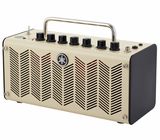For practicing guitar at home, at low-to-moderate volume levels, it makes a whole lot of sense to have a small desktop amplifier that would project the sound more or less at the player's face, making the experience much more pleasant than when using a regular combo, which would usually be placed at (or even below) the player's knee level. It was truly ingenious — and also rather bold! — of Yamaha to release the THR (a.k.a. The Third Amp) series, which has since inspired a multitude of copycats. The THR5 not only looks right at home on my desk (like a vintage radio), but it also sounds great! It was, to my knowledge, co-developed with the Yamaha's Hi-Fi department, so it is not by accident that it sounds as good as a stereo loudspeaker as it does as a guitar amplifier. I connect it to my laptop and use it for watching movies and listening to music. Yes, the transducers in the THR5 are rather small, but they are still much larger than the ones in my laptop, so the low frequency response is greatly improved. As an amplifier, it is rather simple. The biggest shortcomings (for me) are the lack of separate treble and bass controls (it only has a single knob, labeled “Tone”) and the difficult-to-dial-in tremolo effect (even at its lowest setting, it is still too fast for my liking). The latter issue, however, could likely be resolved with the THR Editor software (I have not had the time to download it yet). The built-in chromatic tuner is as basic as it gets, but it gets the job done; and the tap tempo function is a nice touch. I only wish it worked for the tremolo too, not just for the delay. When it comes to reverbs, the hall sounds great, but I found the spring to be somewhat underwhelming. First of all, it seems a little bit “darker” than what I am used to hearing from my Fender. Secondly, it lacks the so-called “drip”. For the price, it is great, but do not expect it to replace a real spring unit. Summing up my review, I can say that the THR is well built for what it costs, the only potential weak point being the power supply. The problem is that the THR5 uses a DC power supply (similar to what old laptops used to come with) instead of the usual IEC cable. And not only that: it is also 15 volts, making it more or less proprietary (most pedal power supplies are 9, 12, or 18 volts), and it connects to a PCB-mounted power jack. Since I keep my THR5 on my desk and never move it, it is not an issue, but if you intend to be carrying it around, you will have to be careful. Mind you, it is the case with nearly all practice amplifiers that can also be battery powered: Roland Mobile Cube, Boss Dual Cube LX, etc. Another problem with a bulky power supply is that you have to carry more things: not just the amplifier and the power cable, but also a rather hefty “power brick”. But for me, the biggest flaw by far of this lovely amplifier is one of its trademark features — when you turn the unit on, two orange LEDs behind the speaker grille gradually turn on, producing a tube-like glow. It does look nice, and it sets the THR5 apart from all the others, but for someone like myself, who enjoys playing in the dark while watching movies, having it glow next to my laptop screen is a big distraction. I suppose, I could remove the LEDs or stick some black tape over them if I really wanted to, but I wish I were able to switch them on and off. Other than the aforementioned flaws, the THR5 is the highest quality, the best sounding, and the most practical practice amplifier that I have ever owned!


